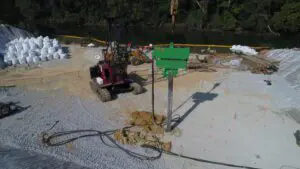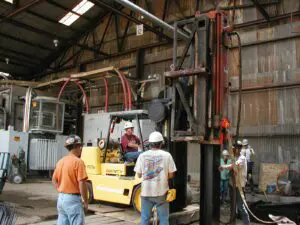American Deep Foundation, Inc. has driven thousands of steel H piles throughout the southeast in varying geotechnical conditions.
Steel H Piles have several advantages over other types of drilled and driven piles.
H Pile material is readily available
 Steel H piles are produced by several mills throughout the United States and abroad. Common sizes such as HP10X42, HP12X53, HP14X73 and HP14X89 are stocked by many suppliers and, in many cases, can be shipped to a jobsite for immediate use. For large projects or for less common pile sizes it may be necessary or less expensive to order the pile material to be produced in a mill rolling. Mill rollings for H pile material are scheduled based on demand but typically occur approximately once monthly. During periods of high demand for pile material, the steel rolling will fill up and it may be necessary to wait for a second rolling.
Steel H piles are produced by several mills throughout the United States and abroad. Common sizes such as HP10X42, HP12X53, HP14X73 and HP14X89 are stocked by many suppliers and, in many cases, can be shipped to a jobsite for immediate use. For large projects or for less common pile sizes it may be necessary or less expensive to order the pile material to be produced in a mill rolling. Mill rollings for H pile material are scheduled based on demand but typically occur approximately once monthly. During periods of high demand for pile material, the steel rolling will fill up and it may be necessary to wait for a second rolling.
Variations in H pile properties can be used to design a pile specifically for the project requirements
Steel H piles are typically made using 36 KSI or 50 KSI steel but higher yield strengths are available. Lengths of steel H piles produced are usually in five foot increments up to 60 feet or longer if transportation is available for the longer lengths. Sizes of steel H piles range from 8 inches to 18 inches square, with 8 inches to 14 inches being the most common.
In the field, steel H piles are very adaptable
In situations where the length of piles vary and cannot be predicted prior to driving, steel piles can be easily cut off using an oxygen/acetylene torch. The cut off sections can then be spliced on to other piles either before or after driving to make them longer. During driving, additional pile splices can be made to add length until the pile reaches an adequate depth or blow count to indicate that it has the necessary load bearing capacity. Splices can be made using full penetration butt welds, in accordance with the ASTM standard or a prefabricated splicer, which allows a splice to be made with less welding. Both types of splices will develop the full strength of the beam.
 Determining the bearing capacity of a steel H pile is relatively easy and economical
Determining the bearing capacity of a steel H pile is relatively easy and economical
Since an H pile is a driven pile, the capacity of the pile can be determined by counting the number of hammer blows required to move the pile over a distance of one inch or one foot. There are many pile driving formulas and computer programs that can be used to accurately estimate the pile capacity. As projects become larger and pile capacities become greater, it becomes more advantageous to more accurately measure the pile capacity. Pile capacity can be verified by static or dynamic testing. Dynamic testing is performed by drilling small holes in the H pile and mounting strain gauges on the pile to determine the elastic shortening of the pile during each blow of the pile hammer. The recorded movement of the pile is then analyzed using CAPWAP software. Static testing is performed by installing reaction piles around the test pile, attaching a test beam to the reaction piles and jacking against the test beam to load the pile being tested. Static load tests are normally run to two or two- and one-half times the design capacity of the test pile.
 Steel H piles can be driven through some types of obstructions
Steel H piles can be driven through some types of obstructions
HP piles can be very stiff for the volume that they displace and can transmit a good deal of energy to the tip of the pile, which allows them to be driven through a variety of obstructions such as wood, debris and thin rock layers. A pile point can be welded to the tip of the pile in order to help the H pile maintain its dimensions and structural integrity as it penetrates the obstruction.
In some geotechnical conditions H piles can be driven deeper into the bearing stratum to a greater capacity
Again, because of the stiffness of some H piles compared to the volume that they displace, steel H piles are able to penetrate deeper into materials than many other pile types. Because of this, they are able to achieve higher capacities at the same location by obtaining more friction because of the deeper depth in the dense material, by reaching end bearing on material that a different pile could not reach or by a combination of friction and end bearing. As in driving through obstructions, welding a pile point to the tip of the pile will help to maintain the dimensions and the structural integrity of the HP pile while it is penetrating dense material.
Steel H piles cause less vibration to affect adjacent structures
Steel H piles are considered non-displacement piles in that they displace very little material as they are installed. Because of this, they are less likely to have adverse effects on surrounding structures or improvements than displacement piles than displace greater amounts of material.
Structural steel piles are very durable and long lasting
Depending on the location of the project, designers may include one eighth inch of extra steel to allow for corrosion. In extremely corrosive environments, a coating, sometimes of coal tar epoxy, may be applied to the surface of the piles to reduce or prevent corrosion. In many cases, the H pile is only coated on the upper portion of the pile. It appears from studies that very little corrosion occurs in undisturbed soil.
Typically, steel H piles can be pulled
Should a steel H pile hit an obstruction, be driven out of location or need to be removed for some other reason, it can normally be removed using a vibratory hammer. If undamaged, the pile can then be redriven in another location or the same location after the obstruction is removed.
Steel H piles can be installed as Limited Access Piles
When piles need to be installed inside of a building or if the pile equipment needs to move through restrictive areas such as under pipe racks or through narrow alleyways, steel H piles can be installed in shorter sections with smaller equipment. In this case, American Deep Foundation installs H piles with side grip vibratory hammers or pneumatic hammers using smaller equipment specially equipped for that purpose.
H piles have lower upfront costs
Depending on the size and length of piles to be installed, equipment to install H piles can often be mobilized less expensively than equipment to install drilled piles or driven precast concrete piles. In addition, since the capacity of a driven pile can be determined by the blow count of the hammer or by using the pile driving analyzer (PDA) without having to wait for grout cure time, it is possible to avoid the cost of waiting for or performing a static load test as would likely be required for a drilled pile project.
Of course, steel H piles are not the correct pile for every application. Typically, the cost of material is more expensive than for pipe piles, precast concrete piles or for drilled concrete piles; however, depending on the project this can be offset by lower installation costs or capacity advantages. American Deep Foundation installs the majority of types of drilled and driven piles. Please review our services page for more information.
GEORGIA OFFICE
info@AmericanDeepFoundation.com
NORTH CAROLINA OFFICE
SOUTH CENTRAL OFFICE
info@AmericanDeepFoundation.com
EAST COAST OFFICE

